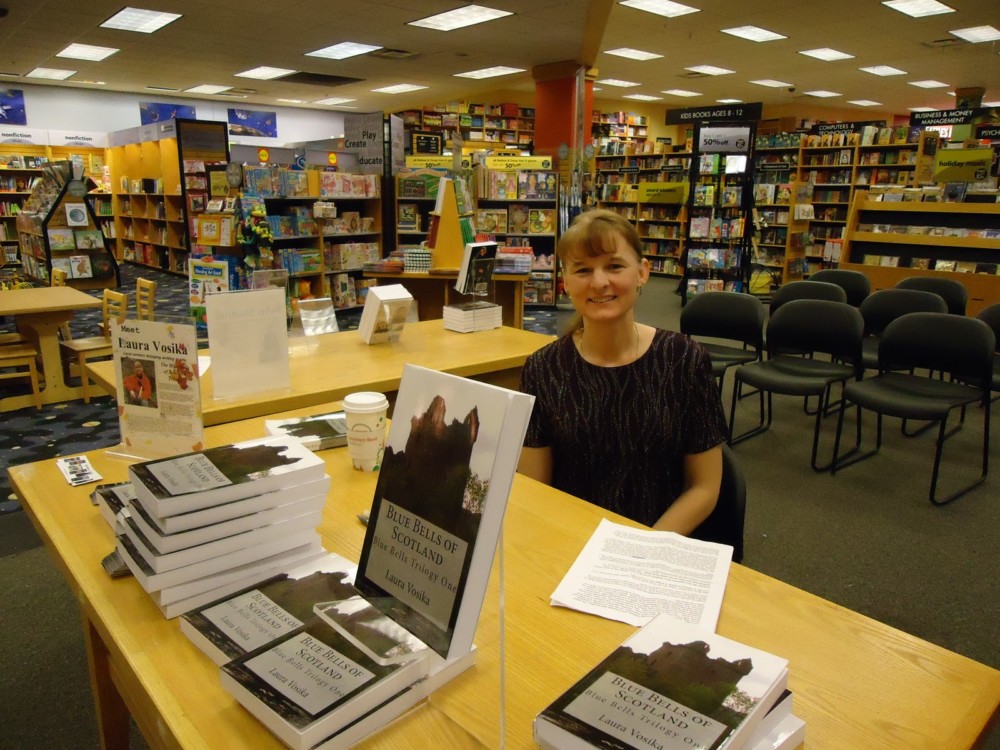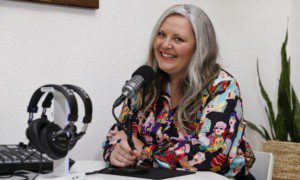By Hannah Covington
Star Tribune (Minneapolis)
WWR Article Summary (tl;dr) Laura Vosika counts herself among a rapidly growing number of authors looking for an alternative to traditional publishing. Vosika helps run an independent publishing house out of her home, which has published nearly 40 books from more than a dozen authors.
Star Tribune (Minneapolis)
From the high-top chair at her kitchen counter, Laura Vosika reigns as queen of two kingdoms.
It’s hard to say which world packs more thrills — the one she inhabits here in Brooklyn Park, where she has raised nine children and now sits surrounded by the six still at home, where her household menagerie includes 40 musical instruments, three cats and one 95-pound Irish Wolfhound.
Or there’s the one Vosika creates in her time-traveling Scottish adventure novels in “The Blue Bells Chronicles” series.
Since she first began self-publishing in 2009, Vosika has sold about 60,000 copies and also helped foster a vibrant north metro indie publishing scene.
She counts herself among a rapidly growing number of authors looking for an alternative to traditional publishing. She helps run an independent publishing house, Gabriel’s Horn Press, out of her home, which has published nearly 40 books from more than a dozen authors.
As she perches on her kitchen chair, the morning begins with the predawn whistle of a teakettle and a formidable to-do list.
The scene around her is a blur of bookbags and goodbyes as four school-aged children make grabs for breakfast while cats paw at kibble belonging to the wolfhound who, at this moment, is skittering toward the sliding glass door.
But by 7 a.m., Vosika has shifted her laptop open and is chipping away at a blog post. Coincidentally, her writing prompt today reads: “Why I didn’t get my work done.”
“The bus is here!” yells her 14-year-old son, Connor, at 7:15 a.m.
Vosika bolts for the front door, shouting, “Run!” as she swings it open. Then, it’s back to her blog post and to-do list.
The 48-year-old writer learned long ago how to juggle the worlds of motherhood and authorship. She tapped out her first novel with all nine children still at home.
That first book emerged in 2005 at the end of a 30-day writing marathon known as National Novel Writing Month, or NaNoWriMo.
The annual event tasks participants with penning a 50,000-word novel in November. This year, about 300,000 people participated. Organizers describe the Twin Cities as one of the most active NaNoWriMo regions in the country.
For Vosika, novel writing interweaves with her love of history and music. She has a master’s degree in education and teaches music lessons on a dizzying array of instruments — piano, harp, flute, clarinet, saxophone, trombone, trumpet, French horn and violin, to name a few.
The world of her novels has a way of seeping into everyday moments. Sometimes, sitting beside a piano student, she has to quiet the medieval warriors still doing battle in her head.
“You think for a moment, ‘Wait, I’m in the wrong place,’ ” she said. “These stories are there, and they have to get out.”
Changing landscape
The landscape indie authors like Vosika now inhabit is a far cry from the one that existed even a decade ago, given the ongoing boom in the self-publishing scene. One measure of this growth is the number of International Standard Book Numbers, or ISBNs, assigned to self-published titles. An ISBN acts as a product identifier, and they ballooned 375 percent from 2010 to 2015, jumping from 152,978 to 727,125, according to a recent report from Bowker, a ProQuest affiliate and the official U.S. ISBN agency.
While tracking ISBNs is not a strict title count — authors often give different ISBNs for the print and digital formats of the same book — it does indicate the rapid growth in self-publishing, said Beat Barblan, Bowker’s director of identifier services.
Coupled with this growth is the emerging impulse among writers to see themselves “not just as authors but as entrepreneurs,” Barblan added.
Print-on-demand services have made self-publishing easier, with authors turning to digital platforms like CreateSpace, Smashwords and Lulu to ready their manuscripts for sale. And while online platforms account for the majority of sales for many indie authors, a growing number are also reaching out to brick-and-mortar bookstores.
Booksellers, in turn, are figuring out how to manage the influx of self-published authors stopping by about their books, said Carrie Obry, executive director of the Midwest Independent Booksellers Association.
“This wasn’t happening a few years back,” Obry said. “It just goes to show how active this field is.”
But self-publishing also comes loaded with challenges. Authors are responsible for editing, formatting, designing and marketing their own works, without the resources of traditional publishing houses.
And in a sea of such mind-boggling quantity, literary quality can become an issue — a reality indie authors like Vosika readily admit.
“There are a lot of people out there writing really good books,” Vosika said. “But some could benefit from more editing and a writers group.”
For Vosika, that’s where Wednesday nights come in.
Weekly support
They call themselves the Night Writers, and it’s here, in a Lutheran church in Maple Grove, that members revise and retune words until they sing off the page.
From this writers group came Gabriel’s Horn Press, which Vosika and Jack Stanton, a former member, started in 2009. Until recently, most of the books published through the indie publishing house got their start during Wednesday nights from the dozen or so group members, some of whom have been meeting weekly for nearly 30 years.
When Vosika joined Night Writers 10 years ago — it once met in a community center where she taught music lessons — she brought “computer world” savvy with her, said longtime member Genny Zak Kieley.
“She’s kind of a savant,” Kieley said. “She’s this Christian woman with really good values. She travels to Scotland. Sometimes we talk about, ‘When does she sleep? How can she add one more thing?’ ”
“I saw her planner one time,” Kieley added. “Any of us would keel over if we had to do it all.”
Blurring worlds
Back in Vosika’s kitchen, her planner sits open, reminding her to edit a manuscript for a new author, design a book cover, prune paragraphs from her own novel and practice harp for a weekend festival.
In the home she’s created, imagination gives life a gilded edge. Her children make music, shoot movies and write stories of their own.
Her latest work, “Food and Feast,” weaves together themes of family, faith and history, interspersed with more than 200 medieval and modern recipes, like bough cakes — dried fruit coated in ale batter and cooked on a stick — and hot wassail.
In Vosika’s kitchen, even Thanksgiving leftovers have been known to take on a storybook flair.
















































































































































































































































































































































































